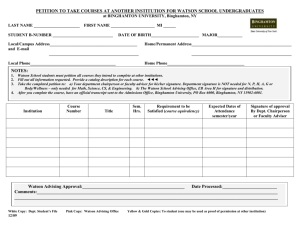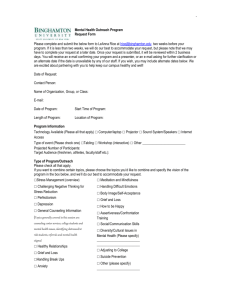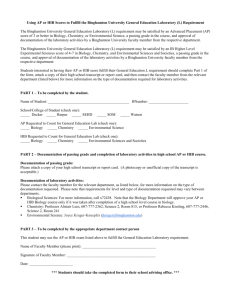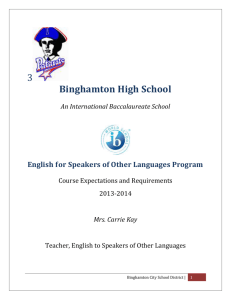syllabus template
advertisement
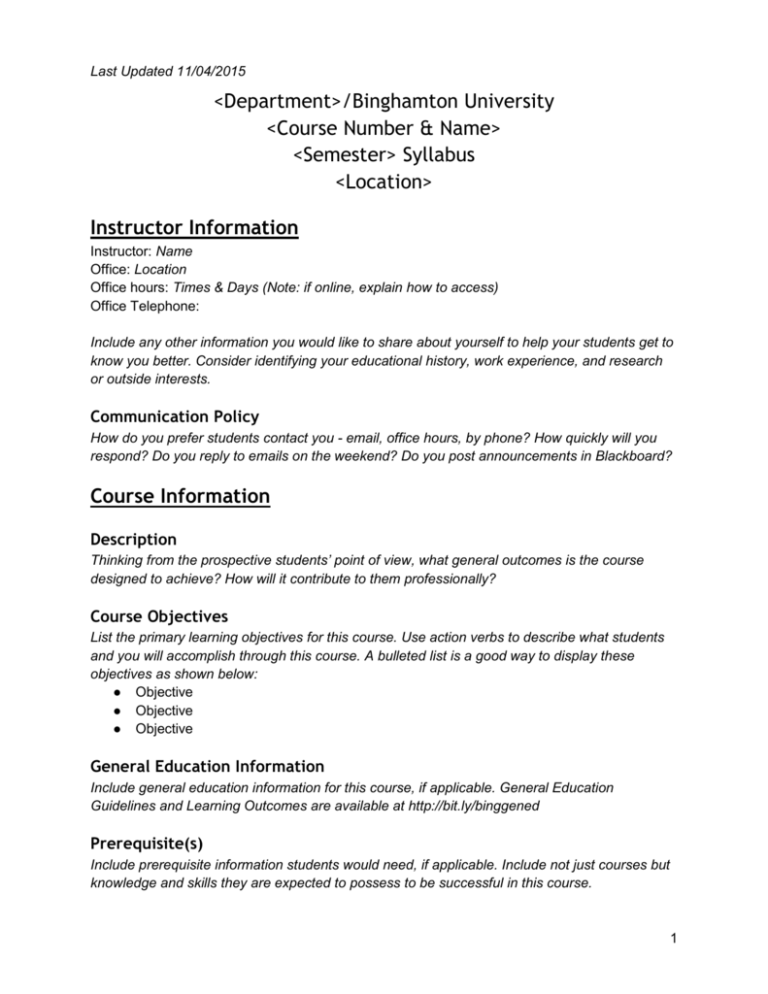
Last Updated 11/04/2015 <Department>/Binghamton University <Course Number & Name> <Semester> Syllabus <Location> Instructor Information Instructor: Name Office: Location Office hours: Times & Days (Note: if online, explain how to access) Office Telephone: Include any other information you would like to share about yourself to help your students get to know you better. Consider identifying your educational history, work experience, and research or outside interests. Communication Policy How do you prefer students contact you - email, office hours, by phone? How quickly will you respond? Do you reply to emails on the weekend? Do you post announcements in Blackboard? Course Information Description Thinking from the prospective students’ point of view, what general outcomes is the course designed to achieve? How will it contribute to them professionally? Course Objectives List the primary learning objectives for this course. Use action verbs to describe what students and you will accomplish through this course. A bulleted list is a good way to display these objectives as shown below: ● Objective ● Objective ● Objective General Education Information Include general education information for this course, if applicable. General Education Guidelines and Learning Outcomes are available at http://bit.ly/binggened Prerequisite(s) Include prerequisite information students would need, if applicable. Include not just courses but knowledge and skills they are expected to possess to be successful in this course. 1 Last Updated 11/04/2015 Relationship to Other Courses How does this course relate to the rest of their program of study? Discipline/College/Department- Specific Information or Standards Include any discipline/college/department specific information, such as accreditation standards Format and Procedures How is the course structured and how will classes be carried out? If the course has multiple formats (like lecture & recitation, lab and discussion, group learning projects and/or presentations) these should be explained clearly Course Requirements Required text ● List required course textbooks. Include detail such as full name of textbook, author, edition, ISBN, description (if desired), and where it can be purchased. If a required text is available online, indicate where it can be accessed. Other Requirements ● ● Internet and Blackboard access List other tools, resources, and materials needed by the student for success in the course (MyLab account, i>clicker, special clothing, special calculator, etc.) and where they can purchase these items. Recommended Texts & Other Readings ● ● List of readings available and how/where to access them. Include a general statement such as - Other readings will be made available in Blackboard (See Folder Name). Credit Hours and Expectations Include the text from the provost’s office document that applies to course <http://bit.ly/1h6CTB8> This course is a 4-credit course, which means that in addition to the scheduled lectures/discussions, students are expected to do at least 9.5 hours of course-related work each week during the semester. This includes things like: completing assigned readings, participating in lab sessions, studying for tests and examinations, preparing written assignments, completing internship or clinical placement requirements, and other tasks that must be completed to earn credit in the course. Assignments Enter a list of your course assignments and descriptions. Consider including detailed directions, including submission guidelines and rubrics. You may choose to include this information in an 2 Last Updated 11/04/2015 appendix to the syllabus or on Blackboard. This section may be combined with the subsequent section on grading. Grading Include details about how the student will be evaluated - what factors will be included or not included, how they will be weighted and how they will be translated into grades. In addition to this explanation, the grading scale must be included. Keep in mind, the weighting of amount of points for the different assignments and tasks you give students will have a major impact on their effort distribution. For example, if you have many homework assignments and/or quizzes, but not any one of them will count significantly toward the final grade, students may invest less time and commitment to doing them. Assignment Name Points Possible Percent of Total Test 1 100 25% etc etc etc Grading Scheme Define your grading scheme for the course (your department may have a specific grading schema that is required.) Grade Points Percent A 900-1000 90-100% etc etc etc Accessing Grades How will students access their grades? Will they be available on Blackboard? Course Policies Late Policy Include your courses policy on submitting late work or completing make-up exams. Attendance & Participation How are students expected to participate in class? If a certain percentage of the students’ grades is based on class participation, what criteria will be used to make that assessment: quantity or quality? If quality, what determines quality? Publishing your rubrics for how you determine student performance on an assignment is advisable (though you may not want to put rubrics for all assignments in the syllabus) 3 Last Updated 11/04/2015 Example wording: Class attendance and participation points are given to encourage your active class participation and discussion. You will be rewarded with a perfect score as long as you frequently come to class and actively contribute to the class discussion during recitations and lectures. Although it is not required, most students send their professor a brief e-mail to explain their absence in advance. Students who repeatedly arrive late to the lecture or recitation will have their Class Participation grade lowered. Please sign the attendance sheet when you come to the class. Any false signatures will result in zero participation grades for all parties involved. Class participation is a very important part of the learning process in this course. You will be evaluated on the QUALITY of your contributions and insights. Quality comments possess one or more of the following properties: ● Offers a different and unique, but relevant, perspective; ● Contributes to moving the discussion and analysis forward; ● Builds on other comments; ● Transcends the “I feel” syndrome. That is, it includes some evidence, argumentation, or recognition of inherent tradeoffs. In other words, the comment demonstrates some reflective thinking. We will use our assessment of your participation to manage borderline grades. While your participation grade is subjective, it will not be random or arbitrary. And, clearly, more frequent quality comments are better than less frequent quality comments. Use of Mobile Devices Example wording: As research on learning shows, unexpected noises and movement automatically divert and capture people's attention, which means you are affecting everyone’s learning experience if your cell phone, tablet, laptop, etc. makes noise or is visually distracting during class. For this reason, I [insert the language that aligns with your sentiments] ● ask you to turn off your mobile devices and close your laptops during class. ● allow you to take notes on your laptop, but you must turn the sound off so that you do not disrupt other students' learning. If you are doing anything other than taking notes on your laptop, please sit in the back row so that other students are not distracted by your screen. Understand When You May Drop This Course - Incomplete Policy Academic Integrity Sample statement: Binghamton University provides explicit guidelines in the Student Academic Honesty Code (see the University Bulletin - Academic Policies and Procedures for All Students). Unless specified otherwise in the syllabus, I expect the work you submit for grading to be yours 4 Last Updated 11/04/2015 and yours alone. Not acknowledging another's work with proper references, taking credit for someone else's work, letting your work appear in another student's paper, or fabricating "results" are grounds for failing the assignment and/or the course. If you have any questions about what constitutes plagiarism or cheating, please ask me. Disability-Related Equal Access Accommodations Statement In-person course statement: Students wishing to request academic accommodations to insure their equitable access and participation in this course should notify the instructor as soon as they are aware of their need for such arrangements. Authorizations from Services for Students with Disabilities (SSD) are generally required. We encourage you to contact SSD at (607) 777-2686 to schedule an appointment with the Director or Learning Disabilities Specialist. The SSD website (www.binghamton.edu/ssd/) includes information regarding their Disability Documentation Guidelines. The office is located in UU – 119. Distance-learning course statement: Students wishing to request academic accommodations to insure equitable access and participation in this course should contact Binghamton University’s Services for Students with Disabilities (SSD) office. Please visit the SSD website (www.binghamton.edu/ssd/) for contact information, Disability Documentation Guidelines, services, policies and procedures. Campus Help for Students (Refer students to any campus resources or online resources that you feel will be helpful for them in completing your course successfully. Examples follow.) University Tutoring Services UTS offers free tutoring for undergraduate students at Binghamton University. All UTS tutoring appointments must be scheduled online through TutorTrac at tutortrac.binghamton.edu. Students log in using their PODS username and password. Walk-in tutoring is also available for select courses. If you have any questions about UTS, call 607-777-9235, email uts@binghamton.edu, or visit the website: http://www.binghamton.edu/tutoring. ITS Helpdesk Walk-in: Located in the Computer Center first floor lobby. Call: 607-777-6420; E-mail: helpdesk@binghamton.edu. https://www.binghamton.edu/its/ Blackboard Support E-mail: blackboard@binghamton. edu Call Tami Regulski: 607-777-6145, Andrea Witteman: 607-777-6457, Carol Bell: 607-777-6362 http://www.binghamton.edu/uctd/ 5 Last Updated 11/04/2015 Libraries The Libraries offer a wide variety and range of services including research assistance, instruction, user-friendly interfaces, digital preservation, digital scanners, and resource sharing. Text: 607-205-8173; Call: 607-777-2345; Email: refquest@binghamton.edu http://www.binghamton.edu/libraries Dean of Students If you are experiencing undue personal or academic stress at any time during the semester or need to talk with someone about a personal problem or situation, I encourage you to seek support as soon as possible. I am available to talk with you about stresses related to your work in my class. Additionally, I can assist you in reaching out to any one of a wide range of campus resources, including: 1. Dean of Students Office: 607-777-2804 2. Decker Student Health Services Center: 607-777-2221 3. University Police: On campus emergency, 911 4. University Counseling Center: 607-777-2772 5. Interpersonal Violence Prevention: 607-777-3062 6. Harpur Advising: 607-777-6305 7. Office of International Student & Scholar Services: 607-777-2510 University Counseling Center At some point during their college experience, students may encounter personal, social, or developmental issues that call for assistance beyond the advice provided by friends and family. That’s where the University Counseling Center (UCC) can help. The UCC provides a variety of free and confidential counseling services delivered by professional counselors. All currently enrolled Binghamton University undergraduate students, graduate students and affiliated entities are eligible to receive these services free of charge. Services and programs available through the center include individual and group counseling, consultation, referral, and psychoeducational programs. For more information or to make an appointment, visit https://www.binghamton.edu/counseling Topic Outline/Schedule Week (Dates) Topic Readings Activities Due This Week 1 2 3 6 Last Updated 11/04/2015 7
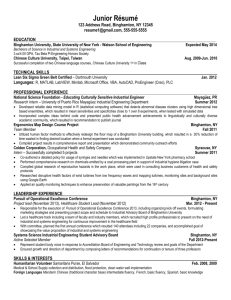
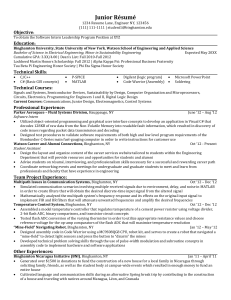
![Laborer Recyclable [posting]](http://s3.studylib.net/store/data/006686214_1-3308c6dd146b5b89a38fa77d3b3e6da5-300x300.png)
